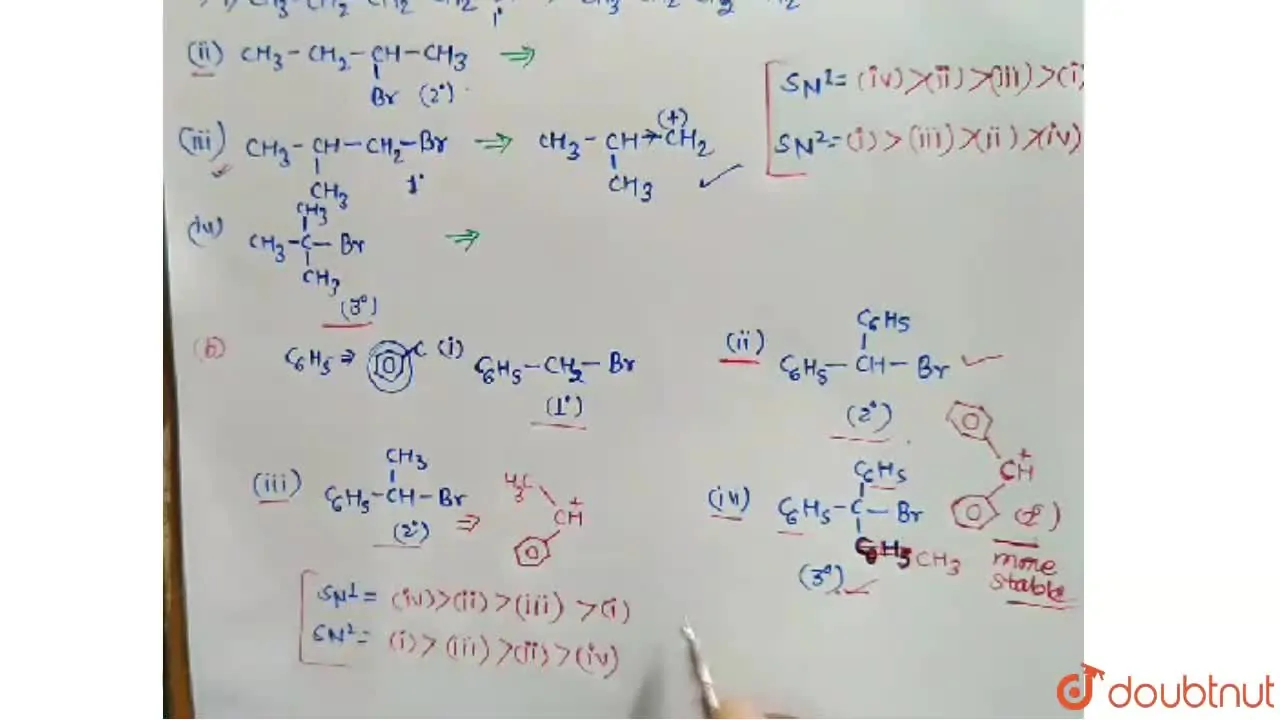Predict the order of reactivity of the following compounds in SN1 and SN2 reactions :
(a) The four isomeric bromobutanes
(b) C6H5CH2Br,C6H5CH(C6H5)Br,C6H5CH(CH3)Br,C6H5C(CH3)(C6H5)Br
(a) The four isomeric bromobutanes are:
(i) CH3CH2CH2CH2Br (ii) CH3C∣CH3HCH2Br (iii) CH3CH2C∣BrHCH3 (iv) CH3−CH3∣C∣CH3−Br
In SN1 reactions, the order of reactivity depends upon the stability of the intermediate carbocations. Since the stability of carbocation decreases as 3∘>2∘>1∘, the order of reactivity also decreases in the same order. (i) and (ii) are primary alkyl halides, but the carbocation intermediate derived from (CH3)2CHCH2Br is more stable than that derived from CH3CH2CH2CH2Br because of greater electron donating inductive effect of (CH3)2CH−group. Therefore, (CH3)2CHCH2Br is more reactive than CH3CH2CH2CH2Br in SN1 reactions. (iii) in a secondary, and (iv) is tertiary bromide. Hence, the order of reactivity in SN1 reaction is:
CH3CH2CH2CH2Br<(CH3)2CHCH2Br<CH3CH2CH(Br)CH3<(CH3)2CBr
The reactivity in SN2 reactions follows the reverse order as the steric hindrance around the electrophilic carbon increases in that order. Thus, the order of reactivity in SN2 reactions is :
CH3CH2CH2CH2Br>(CH3)2CHCH2Br>CH3CH2CH(Br)CH3>(CH3)2CBr
(b) In SN1 reactions, the reactivity increases with increase in stability of the intermediate carbocations formed as 3∘>2∘>1∘. Therefore, C6H5C(CH3)(C6H5)Br which gives 3∘ carbocation [i.e, C6H5C+(CH3)C6H5] is the most reactive. Of the two secondary bromides, C6H5−CH(C6H5)Br and C6H5−CH(CH3)Br, the carbocation intermediate obtained from C6H5−CH(C6H5)Br [i.e., C6H5−CH(C6H5)] is more stable than that obtained from C6H5CH(CH3)Br [i.e., C6H5CH(CH3)] because it is stabilised by two phenyl groups due to resonance. Therefore, C6H5CH(C6H5)Br is more reactive than C6H5CH(CH3)Br.
The fourth alkyl bromide, i.e., C6H5CH2Br which gives primary carbocation i.e., C6H5CH+2 is least reactive. Hence, the overall reactivity of these alkyl bromides towards SN1 reactions decreases as:
For SN1 reaction : C6H5C(CH3)(C6H5)Br>C6H5CH(C6H5)Br>C6H5CH(CH3)Br>C6H5CH2Br
In SN2 reactions, the reactivity depends upon the steric hindrance and decreases as 3∘<2∘<1∘. Therefore, primary bromide, C6H6CH2Br is most reactive and tertiary bromide C6H5C(CH3)(C6H5)Br is least reactive. Among two secondary bromides, C6H5CH(C6H5)Br is less reactive than C6H5CH(CH3)Br because a phenyl group is bulkier than a methyl group and causes more steric hindrance. So, the correct order is
For SN2 reaction: C6H5C(CH3)(C6H5)Br<C6H5CH(C6H5)Br<C6H5CH(CH3)Br<C6H5CH2Br
Related Playlists
- BOOK - MODERN PUBLICATIONCHAPTER - HALOALKANES AND HALOARENESEXERCISE - PRACTICE PROBLEMS30videos
HALOALKANES AND HALOARENES
- BOOK - MODERN PUBLICATIONCHAPTER - HALOALKANES AND HALOARENESEXERCISE - CONCEPTUAL QUESTIONS25videos
HALOALKANES AND HALOARENES
- BOOK - MODERN PUBLICATIONCHAPTER - GENERAL PRINCIPLES AND PROCESSES OF ISOLATION OF ELEMENTSEXERCISE - COMPETION FILE (Integer Type Numerical Value Type Questions)5videos
GENERAL PRINCIPLES AND PROCESSES OF ISOLATION OF ELEMENTS
- BOOK - MODERN PUBLICATIONCHAPTER - ORGANIC COMPOUNDS CONTAINING NITROGEN EXERCISE - UNIT PRACTICE TEST5videos
ORGANIC COMPOUNDS CONTAINING NITROGEN
Similar Questions
Predict the order of reactivity of the following compounds in SN1 and SN2 reactions:
(i) The four isomeric bromobutanes
(ii) C6H5CH2Br,C6H5CH(C6H5)Br,C6H5CH(CH3)Br,C6H5C(CH3)(C6H5)BrView SolutionPredict the order of reactivity of the following compounds in SN1 and SN2 reactions:
(i) The four isomeric bromobutanes
(ii) C6H5CH2Br,C6H5CH(C6H5)Br,C6H5CH(CH3)Br,C6H5C(CH3)(C6H5)BrView SolutionPredict the order of reactivity of the folloiwing compoundss in SN1 and SN2 reacations.
a. The four isomeric bromolbutanes
b. I. C6H5CH2Br
II. C6H5CH(C6H5)Br
III. C6H5CH(CH3Br
IV. C6H5C(CH3(C6H5)BrView SolutionThe decreasing order of reactivity of the following compounds in SN1 reactions is _________.
(i) C6H5CH2Br (ii)C6H5CH(C6H5Br
(iii)C6H5CH(CH3Br (iv)C6H5C(CH3)(C6H5)BrView SolutionC6H5−CH=CH−CO−CH3
View SolutionThe order of reactivity of the following compounds towards electrophilic substitution will be :
(I) C6H5CH3
(II) C6H5CH2CH3
(III) (C6H5CH(CH3)3
(IV) (C6H5C(CH3)3View SolutionThe reactivity of following compound in electrophilic substitution reaction is in the order of
1.C6H5−CH33.C6H5−Cl2.C6H5−Br4.C6H5−NO2View SolutionDistinguish between : (ii) C6H5COCH3andC6H5CH2CHO.
View SolutionThe correct order of reactivity of the compounds
(I) C6H5H2(Br), (II) C6H5CH(C6H5)Br, (III) C6H5CH(CH3)Br, (IV) C6H5C(CH3)(C6H5)Br in the increasing order of reactivity in SN2 reactions isView SolutionArrange the following compounds in the decreasing order of reactivity towards SN2 displacement reaction and give reasons in support of your answer:
(a) C2H5Br,C2H5I,C2H5Cl
(b) (CH3)3CBr,CH3CH2CHBrCH3,CH3CH2CH2CH2Br.View Solution


